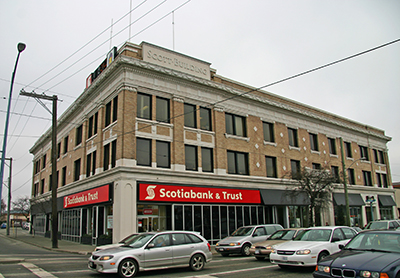ARCHITECTURE:
Scott Building, an Edwardian-era landmark in the Burnside neighbourhood, stands at the confluence of Douglas St, Hillside Av, George Rd E and Government St. [It replaced the 1875 Heisterman House, 2665 Douglas St] Key elements that define its commercial form, scale and massing are its: three-storey height, built to front and side property lines; full basement; rectangular plan; flat roof with parapets, raised at main corner; and ground floor commercial retail units with storefronts facing Douglas St. Masonry construction includes tan brick clad ing on the two main façades, granite plinth blocks and ivory coloured terra cotta lintels, sills, projecting cornices, column bases and capitals, and decorative insets. Edwardian-era decorative features include the tripartite or three floor levels and vertical division with two-storey pilasters. Classical Revival features include running acanthus, dentil and egg-&-dart mouldings, central entry with festoons, garlands, fluted Ionic columns and pilasters, ground floor pilasters with sunken panels and name plaque “Scott Building.” The window arrangement includes original wooden brick-mould and mullions, segmental-arched window openings on the rear elevation, and three leaded coloured-glass transom windows above the central entry.
Designed in an austere manner, the Scott Building represents a superior and elegant example of the Classical Revival style popular during the Edwardian era. The richly-detailed main façades are clad in tan brick and terra cotta, with sophisticated detailing that demonstrates a high quality of design and craftsmanship. The terra cotta on the two main facades is the work of famed California manufacturer Gladding, McBean & Co, founded in 1875 and still in business. It is a significant surviving design by architect Lord Wilfrid Hargreaves (b. Manchester, ENG, 1880-1966) who established his firm here in 1909. He also designed nearby Leland Building (2512 Douglas St) and Queen’s Printer (563 Superior St, James Bay).
ORIGINAL OCCUPANTS:
The Scott Building location illustrates the ongoing redevelopment of the northern edge of the city, in close proximity to the industrial enclaves of Burnside and downtown Victoria. It was built as revenue property for investor Robert Scott (b. Scotland 1858-1922), who by 1875 had be gun fur-trading operations in NW Territories, so successfully it allowed him to open two large stores in Manitoba. He brought butter-makers from Denmark, established the first creamery in the NW at Shoal Lake, MB, and originated the method of shipping butter in sealed tins, shipping as far as the Yukon and Japan. He retired here, then acquired and developed large numbers of investment properties, Scott Building being his flagship property.
Robert married Elizabeth Marshall (née Findlay, b. ON 1870-1955) in Shoal Lake in 1889. From 1907 until their deaths they lived at 1587-95 York Pl in Oak Bay, called Annandale after Scott’s birthplace, designed by architect John Gerhard Tiarks and built 1897-98 for Sir Charles Hibbert Tupper.

